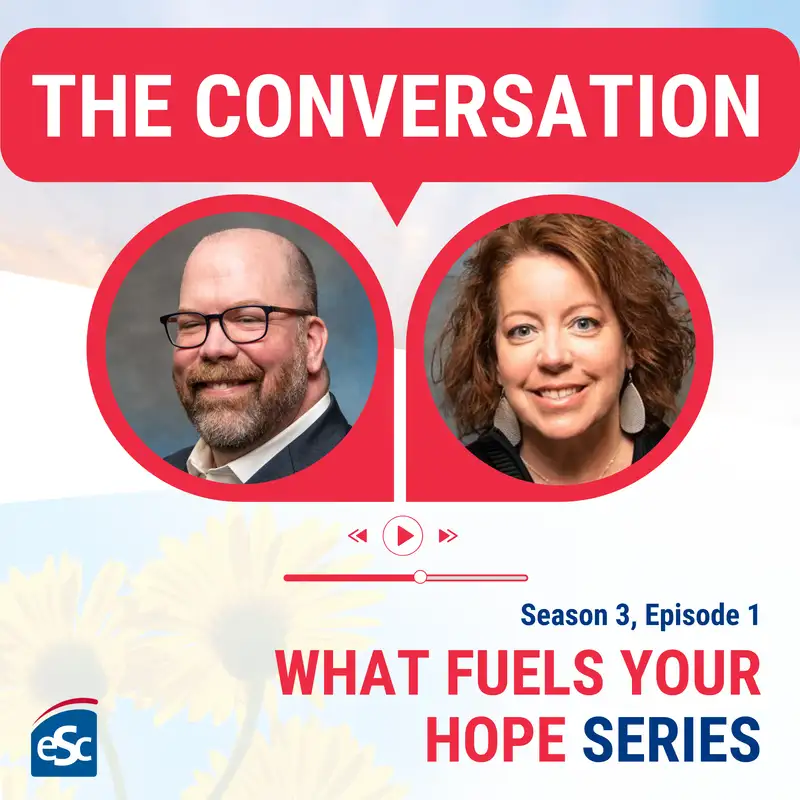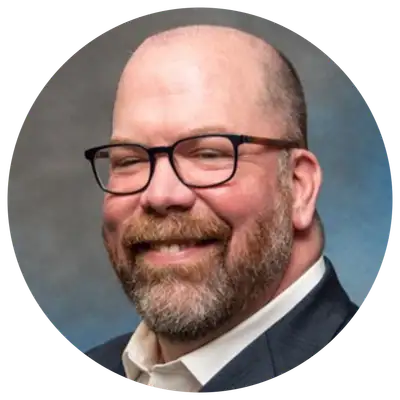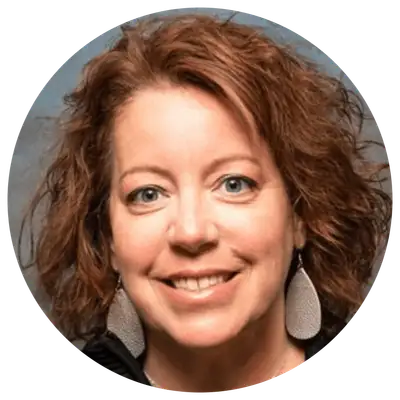
Reigniting the Spark: How a Science Externship Brought Joy Back to Teaching
Announcer:
Welcome to season three of the conversation. This season we're exploring how educators can rediscover joy, cultivate hope, and reconnect with the educational journey. Join us for a season filled with inspiring stories and meaningful insights that celebrate the power of education. Now, back to the episode.
Adam Philpott:
And so the advice I would give is, find something that you're interested in. And you have to get those credit hours and those contact hours for your license anyway, so spend them doing something that you want to do.
Announcer:
That was Adam Philpott, a science teacher at Pickerington local schools. On this episode of the conversation, John and Rachel will explore Adam's externship experience on our research vessel on Lake Erie, and discover how the experience reinvigorated his joy of teaching. Let's dive in.
John Hambrick:
Well, hello, and welcome back to The Conversation, Ohio Voices in Education, igniting ideas, inspiring change. Welcome back with my esteemed co-host, Rachel Daniels. Rachel, so glad we get to be together again today.
Rachel Daniels:
Always a good time.
John Hambrick:
Indeed. We get to talk about so many exciting things and so much of the focus is really student-centric and how students can explore and learn and be ready for their future. Well, today we're going to talk a little bit about the educator experience. We have such a cool story to tell. Sit back, enjoy this conversation about an experience right here in Central Ohio with Adam Philpott, a science teacher at Pickerington High School North, and he's going to share some, I'm just telling you, I think a lot of us are going to raise our hands and be like, "How can we do this?" Adam, welcome to the conversation.
Adam Philpott:
Thanks. Glad to be here.
John Hambrick:
Heck yeah. So glad you're here. Hey, so I kind of set you up here. Can you share with our listening audience about the experience you had? And maybe as you were kind of weaving through that, a little bit about yourself and how you got to be on this really cool educator externship experience?
Adam Philpott:
Yeah, for sure. The story of how I got into this, it goes back to me getting into science education to begin with. I got into science education somewhat circuitously through laboratory research, and then really wanting to work more with people instead of things. So I went back to school, got an education degree. And when I started my career as a science educator, I did my student teaching at West Row North High School under a mentor named Lindsay Manzo. And she's really the one that kind of got me into this originally. She told me about her experience on the Lake Guardian, all the way back in 2006 when, I don't know, she was at grad school at the time or whatever. But it was really her that introduced me to the sea grant scene.
And I found out about this opportunity then I guess, but then I took a class at Stone Lab, which is on an island in Put-in-Bay in Lake Erie, back in 2018. And while I was taking that course, that was mentioned again, that there's this vessel that travels the Great Lakes, the research vessels owned by the EPA. And once a year educators from around the Great Lakes region are able to go there and participate in some actual research that's going on in the lakes, and it rotates from lake to lake. And 2019 was the Lake Erie year, and I thought I'll catch it the next time it comes around to Lake Erie. And that happened to be 2024. So, I applied early in the year and was by the summer I was on the ship.
Rachel Daniels:
It sounds like an incredible experience, and I think I'm about to ask you the toughest question in this podcast conversation. And my question is this. When you think about the time that you spent on Lake Guardian, can you give us what your favorite experience was? Warned you, tough question.
Adam Philpott:
Yeah, yeah. I have several. I think one of my favorites was just being back in the lab again. I remember I started my career off in this laboratory science field. And the research project that I got assigned to on the ship was one that studied algae and algae blooms, and the scientists I worked under Dr. Dominic Derminio out of Keuka College in New York. She was the principal investigator for this algae study that looks at the algae that caused the harmful algal blooms that we get in the Great Lakes, especially in the western basin of Lake Erie, certain years. And a lot of that research was pulling samples out of the water and getting them under a microscope, identifying the species that were there. And that just brought me back to what got me into science as a child anyway. And I just really loved being back in the lab again. I don't know, it awoke something in me that I hadn't been able to do for 10 years or so. Just being in that setting again I think was probably my favorite part of the whole thing.
Rachel Daniels:
So, I'm curious, as a literacy person, an avid reader, I always love to sort of have a picture painted for me. So I'd love to hear about a typical sort of day or part of the process that you experienced when you're doing this lab work, because I can see the passion in your eyes that's a lighting at the spot of you being back in the lab. So, can you just paint a picture for us of what that might have looked like?
Adam Philpott:
Yeah, sure. So I'll give you the first 24 hours, because they were the most intense we get on the ship, I believe it was a Sunday morning, in Cleveland, the port of Cleveland. We aboard the Lake Guardian 116 foot research vessel, I think. It's got cabins, and a galley. It's a full on ship. And after what do some introductory and some safety meetings and things, we are off to our first preset point, which is just GPS coordinates, somewhere on the northern Northwestern side of Lake Erie. So kind of near the Canadian shore a little bit. That we were going to be doing our first sampling at 10:00 P.M. So at 10:00 P.M. we are sending this device down that collects water samples at different depths along the lakes profile. And we're taking those samples back to the lab. We're filtering them out, we're trying to get our algae samples from them. We're also sending samples off to be tested for toxins and for nutrient levels.
Doing all that in a very short amount of time because the next one's coming up at 4:00 in the morning. And so at 4:00 in the morning, we're at our new location, and we're doing the same thing again. And then again at 10:00, and at 12:00. And we hit, I think it was five different points for our next port of call, which was at Put-in-Bay. And that was all within the first 36 hours of the trip. And each time you have to suit up hard hat, work boots, go out to the deck of the ship, make sure help guide the machine down in, grab the samples off, and then run back into the lab and do the things we have to do in the lab for all of our data collection. And in between there, it's breakfast time, it's lunchtime, it's dinner time, we go and eat the ship's galley with the crew. And that was the whirlwind of our first day, day and a half out there. It was stop after stop of data collection.
John Hambrick:
You had this opportunity to do those different stops, get some hands on, sleeves rolled up, research. Any particular takeaways, affirmations that you realize maybe after the experience?
Adam Philpott:
So, this gives me a chance to tell another story. Before the trip, I packed my drone and my stuff. Just on the off chance they'd let me fly it and take some pictures. And I had a conversation with the captain and he was totally cool with me doing that. And at one of our stops midway through, we could tell the water around us was green, and it's not normally that color. It was like algae green. And when I flew the drone up, we could actually see the line where the algae bloom was happening, like the place where the green patch turned into a blue patch all of a sudden, because it went into the water where the bloom wasn't happening.
And just getting that photo of the bigger picture of this, I made our ship look tiny in the middle of this massive green patch in the middle of the lake. Algae creatures were taking advantage of the sunlight and the nutrients available to them, just all levels of, from the way zoomed out above the lake, looking at the lake from as a system, down to the microbiological part, and seeing that whole thing was just a really neat experience for me.
John Hambrick:
Amazing. We've been real fortunate, our current governor and lieutenant governor, they've got a thing for workforce development, and helping educators do this type of externship experience. And they've set up funding to help this really go more and more every year. But there's an underlying theme to that. And that is after these experiences, what are you taking back into the classroom? And either A, did you go with goals of, "This is what I want to be able to bring back for future lesson planning, maybe for future peer professional development"? And then, compared to then post experience, did you decide, "Oh, I need to scratch that, and this is really what I'm going to bring back into the classroom and back to my peers"?
Adam Philpott:
Yeah, I can say I'm not sure I really had precise expectations what I was going to be bringing back. I think maybe I thought I was going to be getting some canned lesson ideas, which I kind of did for a couple of things. But mostly it was a lot of just background knowledge that helps me have more context for the things I teach more than anything else. And now a lot of my lecture slides are pictures of yours truly doing some of the research, so that I can brag about it to my students every time it comes up like, "Oh, by the way, this is an algae bloom. I took this picture. This is me with a sample." So, it's a way to give them stories of my travel adventures along with teaching them the lesson content I have to teach.
But also I have so many other things I brought back. One of them was we learned how to make a net for catching algae, like a DIY thing. The actual nets we were using on the ship were really expensive, and I'm not going to buy one for a classroom. But they said, "Hey, you could just make the same thing if you cut the ends off of a pair of pantyhose, attach them to plastic water bottles." Super simple. So I thought, "Okay, great." I come to school first week of classes, I put in an order for a pack of women's pantyhose, and immediately got audited. So that was a fun discussion to have with the leader of our science department here about why exactly I needed pantyhose for an oceanography class.
So, just a lot of things I didn't know I'd be bringing back, I brought back.
John Hambrick:
I mean, you're going to be telling that story for years to come about that. Now, I'm curious then, have your students had the opportunity to take that in the classroom design of pantyhose and funnel, and gone out into the community to try and capture algae to then bring back into the classroom?
Adam Philpott:
So, that specifically we're going to be doing in the spring, but one of the things we did this fall was we got trained on this device called the Hydrolab. And it is a device that measures a bunch of different water quality parameters. Things like temperature, dissolved oxygen, depth, a handful of others. And that was a device that we can get on loan from the EPA as a result of taking the class, that was considered the training that we needed to be able to access it. So I go on to EPA's website, I order it. They ship me a giant Pelican case with this really expensive machine in to let high school students handle. And it was great. We go out to a nature preserve around here and do some water quality analyses, and some local streams and ponds that we have available to us. And that's one big highlight of the beginning of our year at AP Environmental Science.
Rachel Daniels:
Well, Adam, I have to say that, as a professional developer, your explanation of the experience that you've gone through really makes the case for why schools need to consider less of a focus on whole school professional development, and more of a focus on pedagogical content knowledge, which is a small sort of passion of mine to say that content area folks need more routine training in things that they can bring back to the classroom. And so you have sort of painted the perfect picture for the importance and the value in pedagogical content knowledge work.
So, I'd like to give you an opportunity to provide a little bit of advice to our listeners who might be interested in participating in an externship. Where would you tell folks to start? You hinted at learning from an early mentor in your career, but you have advice for other folks. And here's why I think this is so important. What I'm observed in our conversation is the literal fire in your eyes as you're talking about this, we know that being in the classroom can be really challenging. And I'm speaking for you, but I have a sense that this has reinvigorated your passion in the classroom, and I'd love to have other folks get a sense of where they might be able to tap into similar experiences.
Adam Philpott:
Yeah. The listeners can't see how hard I was nodding to your question just now, but yes, by far the most meaningful professional development I've done in the 10 years I've been an educator are ones that I sought out and picked myself, things that I was interested in. And it was the class I took at Stone Lab in 2018, and it's this, the Lake Guardian. So the advice I would give is, find something that you're interested in. And you have to get those credit hours and those contact hours for your license anyway. So, spend them doing something that you want to do. But I've already decided, the next thing I'm going to start looking into, is there anything like this for astronomy? Because I also teach astronomy. And so that's the next thing I'm going to start looking for, because I'm interested personally in astronomy. And the more that I know about it, I know I'm going to deliver a better product to my students in the end.
Rachel Daniels:
And if I could rule the world, one of the first changes that I would make is to take the word teacher of our lexicon, and I would change this profession's title to lifelong learner, because I think that's what the best teacher, is a learner. And Adam, what you have reminded me today is that there are so many educators out there who really carry that moniker of lifelong learners. So John and I are so thankful to have spent this time with you, to have learned about Lake Guardian and your experience. We will put any resources that you share with us in the show notes. And just want to, again, extend our gratitude for taking time to spend with us today, sharing about this opportunity.
So for John, this is Rachel. Stay curious, and keep up with the conversation.
Creators and Guests


